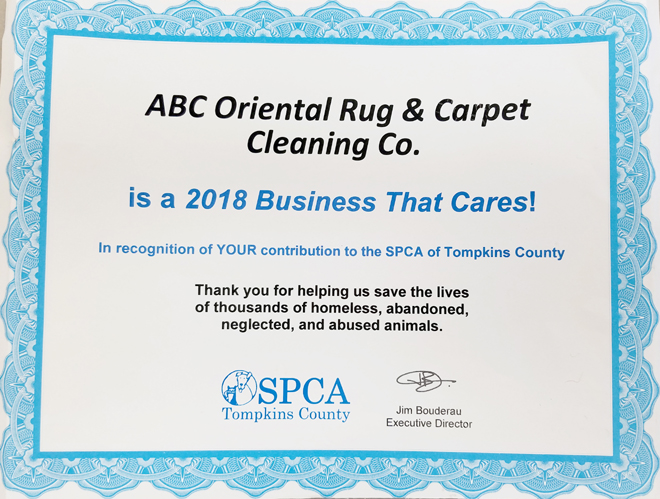ABC MONTHLY NEWSLETTER
DECEMBER 2018
Welcome to Our Monthly Newsletter!
We hope you will enjoy this month's articles.
This month's topics are:
ORIENTAL RUGS
ENVIRONMENTAL CONCERNS
All About Soot
NATURAL FIBERS
PSST!! DON'T FORGET TO CHECK YOUR MAILBOX
If there is a topic you would like us to cover in one of our upcoming newsletters, please call us at
607-272-1566
or contact us by clicking here.
GREAT NEWS!
GOT QUESTIONS?
NOW YOU CAN TEXT US at
607-272-1566
KARABAGH ORIENTAL RUGS
LOCATION
Karabagh rugs (also spelled Karabakh) were woven in the Karabagh region of the southern portion of the Caucasus mountains in present-day eastern Armenia and southwestern Azerbaijan, just north of the present Iranian border.
The region encompasses three areas: Highland Karabagh (historical Artsakh, present-day Nagorno-Karabagh), Lowland Karabagh and a part of Syunik.
Karabagh refers to a region, not an ethnic group. The population is mainly Armenians and Azeri Turks. In the larger cities of mountainous Karabagh, the population is mostly Armenian.
Because the region is split between Armenia and Azerbaijan, as well as between Muslim and Christian and highland and lowland, war and upheavals of its local population has had a long and sad history.
HISTORY
The Karabagh region has long been a center of Azerbaijani (Azeri Turks) arts and culture, since ancient times.The history of the Armenian weavers goes back well into ancient times as well.
Rug weaving had been taking place in this area as far back as the early 13th century. Evidence of weaving crafts has been found at excavations of archaeological sites dating as far back as 2500 BC. Karabagh rugs were among the most prominent exports of the Caucasus region to medieval Europe.
These were the precursors of the rugs we refer to today as antique Karabagh rugs of the 19th and early 20th centuries. This region was at this time one of the most significant rug-producing centers of the world.
Rugs were generally woven in small workshops or individual homes in the small villages where the different ethnic groups lived during different historic times.
Unlike many other rural communities, woven rugs were important symbols of wealth, not just utilitarian crafts. Weaving was considered an essential skill for women, who began learning to weave at age 6 and were expected to weave at least one piece as part of their dowry. Each family was expected to weave at least one rug per month.
Weaving would be the main vocation for a girl's whole life. At their death, their hook, comb, and scissors tools, and their looms were engraved on their tombstones!
The breeding of the white-grey colored wool of the sheep grew tremendously at the turn of the 19th and 20th centuries.
The dyeing skills of the local weavers was extremely important. These experts had to be able to distinguish colors clearly and know how to get the right color from plants and trees.
Often, the vivid magenta-colored field of the early Caucasian Karabagh rugs was considered to be too strong for the Western buyers. This was changed by a chemical process to a dark black-brown color. Unfortunately, because of the iron oxides in the dye, the pile in the field tends to wear down faster than the rest of the rug's pile.
ANTIQUE KARABAGH ORIENTAL RUGS
Antique Karabagh rugs have probably the oldest and most varied patterns of all Caucasian rugs. Their elegance reflects the Armenian and Azerajiani cultures and old traditions.The designs could be woven from a pattern or made freely from the weaver's own imagination.
Although these rugs have many intricate and diverse floral and geometric designs, they have some commonalities they share that make them fit into a distinctive category:
These rugs have longer pile than other Caucasian rugs and are typically more coarse.The weave is distinctive in that it features a double weft between every two rows of knots.There are 2 prevalent types of these rugs from the Karabagh region which became well-known in the 19th century:
Those that descended from Caucasian rugs of the 18th century. These feature tribal geometric and medallion motifs in earthen colors with a lot of folk art, such as small animals.Those closer to Persian rugs with bolder color palettes and Persian designs similar to the Kazak rugs of northern Iran.
ARMENIAN & AZERBAIJANI KARABAGH RUGS
There are Armenian and Azerbaijani types of Karabagh. It is very difficult today to determine which ethnic groups actually wove a particular Karabagh rug since all these rugs are given the name 'Karabagh' in the trade.
ARMENIAN
Armenian rugs were extremely diverse in their style and color. They contained geometric fields, medallions, and motifs. But there were also crosses, human figures, and geometric bird and animal figures that are not usually found in non-Armenian rugs. These may have had religious significance since they are consistent with motifs found in Armenian churches and monasteries.
Some of the motifs used in Armenian rugs may have been the result of contact with India and China as early as the 4th century AD. Some of these motifs include figs, Asoka trees, pine cones, turtles, serpents, and birds.
Armenian inscriptions are an important part of the whole design and give information about both the weaver and the date of the completion of the piece.
Red cochineal dye was first produced by the Armenians.
AZERBAIJANIAN
These were divided into 4 categories: Quba-Shirvan, Genje-Kazak, Karabagh, and Tabriz. Each was different from the rest all depending on different cultural backgrounds, materials available, and local weaving traditions.
Weavers in the Azerbaijani Karabagh region were known for the 'rug set' which was a central rug approximately 13' x 26' long and 6.5' wide along with 2 side rugs the same length of the central carpet and approximately 3' wide. Head and bottom pieces were sometimes added.
PILELESS FLATWEAVE KARABAGH RUGS
Along with the piled Karabagh rugs, these pileless flatweave weavings were also well-known in the region. Palas, Farmash, Kilims, etc. were made into mats, saddlebags, and salt bags. For example, the Palas was a thin, pileless mat that could be made quickly and cheaply for everyday heavy use.
Kilims had traditional patterns and motifs such as the apple, brick, hand, devil chain, tray, bird, fish, and horseshoe.
The Verni was the most widespread type of the pileless flatweave kilim rugs. It's key features were the S-element and vivid bird images as well as the way in which it was woven allowed the pattern to appear on both sides. This rug was thought to protect the family in a home from foul weather.
DESIGN OF KARABAGH ORIENTAL RUGS
To learn more about Karabagh oriental rugs complete with photos and explanation of Caucasian rug symbology, please continue reading here.
ALL ABOUT SOOT
WHAT IS SOOT?
Soot, the byproduct of a fire, whether a raging forest fire or a small kitchen fire, and even from the burning of candles and scents, can pose serious health threats to those who are subject to breathing in the soot particles.
It is the product of material that didn't totally go through the combustion process of burning. The soot found outside after a fire is classified as a criteria pollutant and is regulated by the EPA.
Those who are called in to clean up after a fire is out, such as firemen or cleaning and restoration professionals, understand the dangers involved and how to properly remediate the damage. The majority of consumers may not.
FACTS ABOUT SOOT
- Soot is made up of very fine carbon particles that become airborne and can remain airborne for quite some time.
- These particles can end up in your lungs. You may not even realize it is happening while soot causes damage to your mouth, nose, throat, and, of course, your lungs.
- Even 'harmless' smoke from a fireplace has many chemical similarities to cigarette smoke.Skin contact with soot can be dangerous as well.
- The International Agency for Research on Cancer says the specific type of hydrocarbons in soot are classified as 'known human carcinogens.' Thus, simple contact, not even just breathing in residues, can be potentially harmful.
- Ventilation of the affected areas is required.
- Wearing appropriate PPE (Personal Protective Equipment) is a must for the professionals and it should also be for any consumers who plan to do any of the cleanup work themselves. Proper respiratory, skin, and eye protection should be purchased before attempting any cleaning.
- If the cleanup involves a small fire which is completely out and you are planning to do the cleanup yourself, make sure to use special soot removal sponges on all surfaces before attempting to wash with detergent and water. Soot is oily and oil and water do not mix. Washing will merely spread the soot around.
SOOT FROM THE BURNING OF CANDLES & SCENTS
Delicious smelling scents from candles can provide an inviting fragrance in a home. There are hundreds of scents available, from favorites such as vanilla, citrus, lavender, and more. Yet, as inviting as those scents may be, there are some concerns you should consider as you burn them.
Burning candles can produce pollutants such as acetone, toluene, benzene, and others. These pollutants are also found in soot. It has been noted by various environmental groups and indoor air quality specialists that these scented candles put off smoke, sometimes invisible, that can be leaving an unhealthy residue in your home. If the flame of your candle isn't totally blue, there is no doubt soot is being produced.
HOW TO PROTECT YOURSELF FROM THE POLLUTANTS IN SCENTED CANDLES
- Choose natural wax materials for the candles, such as beeswax or soy, both of which are better choices than wax made from petroleum products and are a safer and healthier choice.
- Make sure your wick is burning adequately. The wick should burn evenly with the melting wax, and curl as it burns. Ensuring the wick is less than ½ inch long when you light it will help.
- Keep your candles burning where there is limited or no draft. Air movement can cause the flame to burn erratically, possibly creating more soot or pollution. Don't burn your candles all the time, just when you are in the mood for a nice scent in the home.
- When you do have issues with candles, such as residue on surfaces in your home, definitely call a professional to help with the cleanup.
SOOT & OTHER SMALL PARTICLES CAN CAUSE SOIL FILTRATION LINES IN WALL-TO-WALL CARPET
Find out what those dark edges along some walls (known as Soil Filtration Lines) in wall-to-wall carpet are and how to avoid them by continuing to read here.s
ABACA NATURAL FIBER
Abaca natural fiber comes from a species of inedible banana native to the Philippines. It is sometimes called Manila Hemp or Musa. (Abaca is pronounced a-ba-ca with the accent on the last syllable.)
The plant is self-sustaining, maturing from 16 to 24 months. It can be harvested 3 times per year once it matures.
A mature Abaca plant consists of from 12 to 30 stalks radiating from a central root system, each stalk from 12 to 20 feet in height. The fibers are extremely strong and grow as layers of overlapping leaf sheaths which form the stalk. The fiber is more coarse on the outer stalks than on the inner ones.
Each stalk is cut into sheaths and then into strips. The strips are scraped to remove the pulp, either by hand or machine.
There are 7 natural shades from the dark brown outer layers to the white inner layers. The white fiber can be dyed to produce any other color.
ABACA NATURAL FIBER EXTRACTION PROCESSES
TUXYING
This is the process of separating the outer sheath, which contains the primary fibers, from the inner leaf sheath, where the secondary fibers are found.
The separated outer leaf sheath is called a tuxy. Tuxying is done by hand stripping and spindle stripping methods.
DECORTICATION
An alternative method of extracting the fiber is by decortication. In this process, the whole leaf sheath is used to extract the fiber, recovering both the primary and the secondary fibers at the same time.
Production with decortication yields from 3.0 to 3.5% fiber while hand tuxying fiber recovery is at 1.0%. The spindle stripping process yields only from 1.5 to 2% fiber.
ADVANTAGES OF ABACA NATURAL FIBER
- Strongest natural plant fiber.
- Durable.
- Flexible.
- Long fiber length.
- Does not swell or lose strength in water.
- Resistant to saltwater damage.
- Self-extinguishing.
- Products obtained from Abaca fibers are eco-friendly.
- Production is energy-efficient - 60% energy savings and reduction of CO2 emissions as well.
HISTORY
During the 19th century, the Abaca natural fiber was widely used for ships' rigging because of its resistance to saltwater damage and the fact it does not swell or lose its strength in water. The pulp was also used to make sturdy manila envelopes.
In 1925 the Dutch in Sumatra began to cultivate the fiber. Around that time also, the US Department of Agriculture began to establish plantations in some areas of Central America.
Today, because Abaca is considered the strongest natural plant fiber, it is used to reinforce polymers and is preferred over synthetic polymers. Recently, Mercedes Benz has used a mixture of polypropylene thermoplastic and Abaca yarn in automobile body parts. Abaca fiber uses an estimated 60% less energy than the energy used in the production of fiberglass.
Over 200,000 Filipino farming families produce Abaca natural fiber as their main source of income. The Philippine nation supplies approximately 90% of the world's Abaca fiber. Other countries including Indonesia, Costa Rica, and Ecuador have obtained Philippine Abaca planting materials and are producing the fiber as well.
USES OF ABACA FIBER
Abaca fiber is a strong, versatile fiber. Since it needs no spinning and has strong, lightweight inner fibers, it is used for garments, hats, and even shoes, as well as rugs, durable furniture, ropes and fishing lines, decorative products such as wallcoverings and home and fashion accessories, as well as specialized papers including coffee filters, tea bags, and banknotes. It is also used for roofing.
Lesser known uses include sausage casings, pill coatings, and surgical masks. It is also used in the production of telephones, orthopedic joint replacements, and fracture-healing implants. In fact, more than 200 different finished products are made from the Abaca plant fibers.
ABACA NATURAL FIBER AND THE PREVENTION OF SOIL EROSION
To learn more Abaca natural fiber and its importance in the prevention of soil erosion as well as information about the Abaca Sustainability Initiative in the Philippines, complete with videos, please continue reading here.
PSST!!!
DON'T FORGET TO CHECK YOUR MAILBOX AT THE END OF DECEMBER FOR YOUR
REGULAR CUSTOMER APPRECIATION DISCOUNT
for JANUARY, FEBRUARY, AND MARCH of 2019
THE DISCOUNTS WILL BE AMAZING!!
ABC's
GIFT OF THE SEASON!
To Our Tompkins, Cortland, & Tioga Co. Friends...
Have an Area Rug Cleaned in our Plant and
RECEIVE 30% OFF
Any In-Home Cleaning
(Wall-to-wall Carpets, Upholstery, Tile & Grout)
(not all services available in all areas)
NOTE: MUST BE SCHEDULED
For Work From
NOVEMBER 15th Through DECEMBER 15th
CALL 607-272-1566
to Schedule TODAY!

ABC & COPS, KIDS, and TOYS
IT'S THE
GIVING SEASON!
*******************
ABC is Again Partnering
with
COPS, KIDS, & TOYS
to
Help Local Families
in the Community
Celebrate Holidays.
*******************
HERE IS HOW
YOU
CAN HELP...
*******************
Bring an Unwrapped,Unopened,Non-Violent,New Toy
to our office
130 Cecil Malone Drive - Ithaca
EACH TOY is an Entry for a
$200 Gift Certificate
for
Any of our Services!
Have Your CARPETS, UPHOLSTERY, TILE & GROUT Cleaned at Home
and
Have $20 Taken Off Your Order (above our minimum)
for EACH TOY You Donate!
(up to 3 toys maximum)
CALL FOR MORE INFO
OR TO SCHEDULE TODAY!
(some services not available in all areas)
*********************
607-272-1566
*********************
THANK YOU!! WE LOOK FORWARD TO CONTINUING TO SERVE YOUR TEXTILE CLEANING AND REPAIR NEEDS!
Get New Posts Right To Your Inbox!
Get our monthly newsletter, just like this one, delivered right to your inbox each day. Just sign up and we will send you the best new articles and videos as they become available.
Your email address will NEVER be spammed, sold, or shared. You are welcome to unsubscribe at any time with the link in the email.
Top of December 2018 Newsletter
"The Cleanest Clean You've Ever Seen."
by
ABC Oriental Rug & Carpet Cleaning Co.
130 Cecil Malone Drive Ithaca, NY 14850
607-272-1566

ABC
Carpet & Rug
Spotting Guide

ABC Oriental Rug & Carpet Cleaning Co. has been family-owned and operated in Ithaca and surrounding areas for more than 48 years.
Our company is a reflection of our family name and pride.
Please Like us on Facebook!
for more information and to find out what we are doing at our business and in the community!
Stay Connected!
Links to Our Services
Allergy Cleaning
Area Rug Cleaning
Oriental Rug Cleaning
Rug Hand & Machine Repair
Upholstered Furniture Cleaning
Tile & Grout Cleaning & Sealing
We are proud sponsors of the SPCA of Tompkins CO:

Newsletter Archives

